Dear Gluten Free Friends: This post is very whole wheaty and not at all helpful to your gluten free life. I’ve got your back though because as you know, many of the recipes here on my site are naturally gluten free. After all, while I do love freshly ground whole wheat flour, I also love variety and breadless recipes. So just for you: 100+ Gluten Free Recipes. Click on over and have at it. Love ya much!
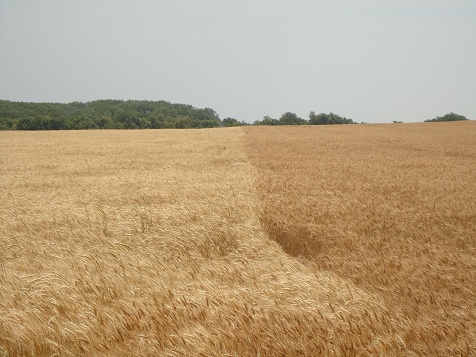
See the difference in grains?
We took this picture while traveling through Kansas a few years ago.
As a newly-wed I remember visiting someone’s house where they served homemade rolls made exclusively with whole wheat flour. I tried to like the rolls, but I was used to white rolls made with all-purpose flour, and these rolls just weren’t the same. I decided that I simply didn’t like whole wheat flour, and really, I didn’t like anything considered to be a “health food.” (I thought eating healthy meant I had to eat rice cakes and bean sprouts for every meal.) I continued on my merry way where I ate very few fruits and veggies, drank about a liter of Pepsi every day, and made oodles of delicious cookies and cakes with white flour.
Many years (and way too many gallons of Pepsi) later, one of my friends started selling her homemade bread at our local Farmer’s Market. She had some leftover one night, so she sent a loaf home with me. We ate it for breakfast the next day, and we loved it down to the last crumb. I complimented her up and down next time I saw her, asking what kind it was. “It’s just my regular whole wheat bread recipe.” What?! That bread was whole wheat? Like, whole wheat and white flour mixed, right?! “Nope. 100% whole grain. I grind it myself.”
That is the moment I learned about the different varieties of wheat and the deliciousness of grinding grain into flour. (I never actually knew people did that. Grind your own flour? Seriously?!) I was intrigued. I researched. I asked questions. I saved up for a Nutrimill, stocked up on hard white wheat, and the rest is history.
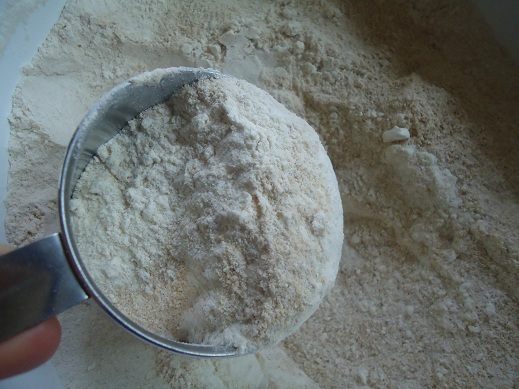
Red Wheat, White Wheat, Hard Wheat, Soft Wheat
Oh how many wheat you meet. Look at me. I’m Dr. Seuss.
There is a big difference between red wheat and white wheat. Both produce whole wheat flour -but they bake up differently, creating different textures and flavors. I’ve covered this in detail in several other posts, which I’ll point you to now:
- The Difference Between Red and White Wheats
- How to Grind Flour in a Nutrimill
- What Kind of Flour is Best if You Don’t Grind Your Own?
- What is Pastry Flour, Where Do I Get it, How Do I Use It?
It’s hard to see the difference in the picture.
Hard is more pointy. Soft is more round. There. Does that help?
The Secret to Fluffy and Delicious Whole Grain Baked Goods
Let’s talk about how you can make the most amazing whole grain cookies, cakes, muffins, pancakes, waffles, and pastries.
When I first started grinding flour to make all of our baked goods healthier and tastier, I used hard white wheat for everything. It did this because:
- Hard white wheat flour works for any recipe, whether it is a yeast bread or a non-yeast product. (Soft wheat only works for non-yeast products.)
- Grinding just one kind of flour made life easier.
Finally, after the recommendation from many of you, I gave soft white wheat a try. This is the variety of wheat that, when ground, produces whole grain pastry flour. I used it first for pancakes, then I used it for muffins, then I decided that I had waited way too long to try this. Pastry flour makes a huge difference in the density of baked goods!
Whole Wheat Pastry Flour (ground from soft white grain) is almost like using white all-purpose flour. It is light and fluffy and baked goods I make with it turn out really delicious.
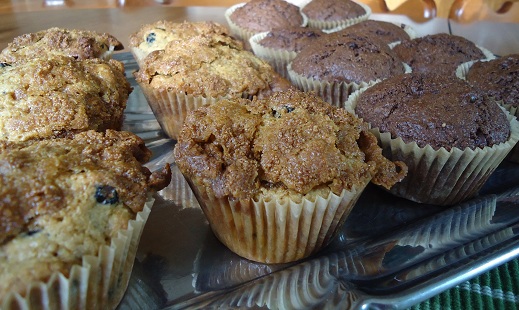
Simple as that, freshly ground Soft White Wheat is the secret to turning out amazing baked goods.
Remember though, if you’re making a yeast bread, you still have to use Hard White (or red) Wheat. I now love both hard and soft white varieties and keep them both on hand at all times for all our baking needs.
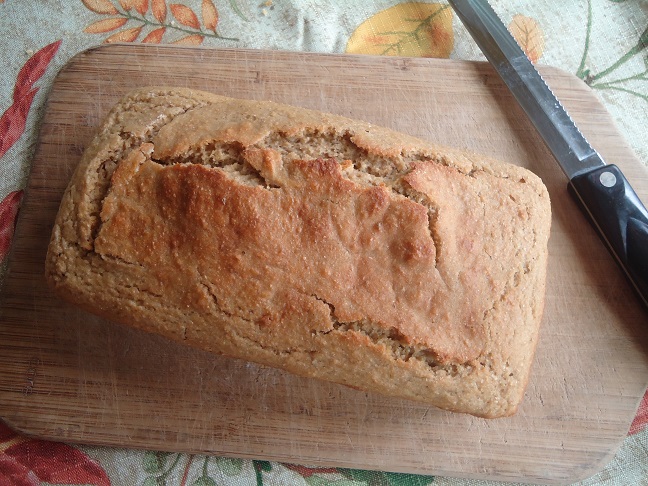
If you’re afraid of baking yeast bread, or simply want to make life much easier –
you have to try this easy Stir-and-Pour Bread. Because of this recipe, I will never knead bread again.
(This bread requires hard wheat, not soft, because it is a yeast bread.)
So let’s review:
- Use hard wheat for yeast breads.
- Use soft wheat for everything else.
- Or use hard wheat for everything – but I’m telling you, soft wheat (which produces whole wheat pastry flour) is wonderful to work with!

Some of our favorite recipes which use Whole Grain Pastry Flour:
Most don’t even realize they are eating whole grains when they eat any of these goodies! For that matter, the recipes that are low in sugar don’t seem to phase people either. Who knew eating healthier could taste so good?!
- Homemade Donuts
- Easy Pancake Muffins
- Low-Sugar Sunshine Cake
- Low-Sugar Super Moist Chocolate Cake
- Low-Sugar Peanut Butter Cake with Peanut Butter Cream Frosting
- Low-Sugar Carrot Cake With Maple Cream Frosting
- Cranberry White Chocolate Chip Breakfast Cookies
- Chocolate Chocolate Chip Muffins
- Blueberry Streusel Muffins
- Breakfast Cake
- Flaky Cream Cheese Pastry
- Oatmeal Breakfast Bars
- Peanut Butter Chocolate Chip Muffins
- Peanut Butter Pancakes
- Zucchini Carrot Bread
- Banana Bread and Muffins
- Bacon Cheese Muffins
Let me hear from you!
- Do you grind your own flour?
- What is your flour preference?
- Have you tried soft wheat (pastry flour) or do you stick with hard wheat for every recipe?
Looking for a great Grain Mill?
I have and highly recommend a Nutrimill!
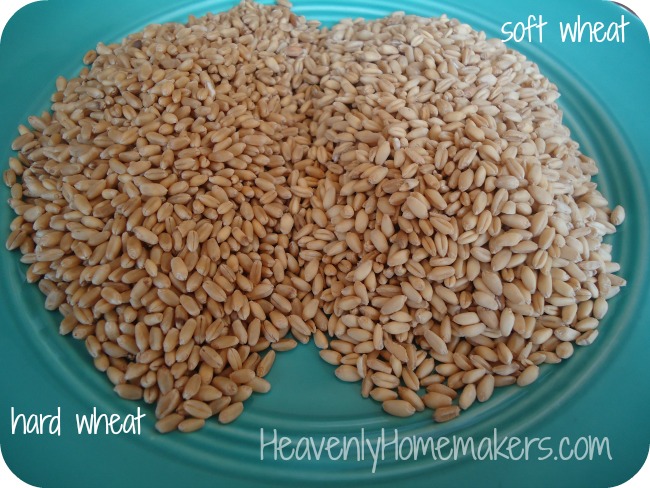

What about for tortillas? Wouldn’t you want to use hard wheat for those or would soft be preferable?
I find that the gluten in hard wheat helps tortillas hold together better. Soft wheat doesn’t work for me as well in tortillas.
Like Joy, I have found that hard wheat works better for tortillas. :)
Hi Laura,
Thanks for such valuable info on the different uses for hard and soft wheat. We just started milling our own grain recently. I’m excited to try your stir and pour recipe today. I was wondering if you’ve milled rye yet, can I make your stir and pour with fresh milled rye alone, blend of hard and rye? What do you recommend?
Just starting to grind flour again. I have bought a nutrimill and used it few time and then life happen with some mountain to overcome. Now I getting back into eating healthy and grinding my own flour. Slow and steady wins the race.
That’s right, good for you!
Is there a price difference between buying the two grains? I don’t have the grinder (am considering one), and I just buy my flour in bulk from Azure. Their pastry flour is about twice as much as hard whole wheat flour. Is the soft wheat that you grind that much more?
Also I too am a stir-and-pour convert, but often my loaves crumble when I’m cutting them for sandwiches. Does this happen to anyone else? Any help as to what I’m doing wrong, or is this bread just prone to that when it’s made in a loaf form? ( I don’t add the cream, but other than that follow the recipe.) I really want to make this bread instead of the kneaded kind, but we do lots of sandwiches here.
Lately soft wheat has been priced a little lower per pound than hard wheat ($57 for 50 pounds of hard wheat and $43 for 50 pounds of soft wheat) – another reason I started using soft wheat more often. It’s strange then that the pastry flour costs more!!
I’ve been skipping both the cream and the egg in the stir-and-pour bread (mostly just for ease to throw it together). Mine does crumble a little, but no more than my kneaded version. It works best for me if I wait until the bread has cooled completely before slicing.
Soft wheat is SO much better for pie crust, too! When I attempted pie crust with hard wheat, it just fell apart. Soft wheat produces a crispier waffle and more tender biscuit and muffin, for sure!
Oh yes, pie crust! Soft wheat turns out beautiful pie. :)
I’ve noticed that there are several different Nutrimill’s, which particular one would you recommend?
I think there’s just one kind, but here’s the link to what I recommend: http://www.paulasbread.com/mills/nutrimill.html
I too would like to know this. Thanks for asking, Kelley!
Hoping you saw my above comment, but just in case: http://www.paulasbread.com/mills/nutrimill.html :)
There is also the Harvest NutriMill, which is the one I have. It is a stone grinder instead of an impact mill. I love it because I can grind to any texture, from superfine to merely cracking the grain.
Okay, I have been meaning to ask you this question for a while, and I hope you or another reader knows the answer. I don’t have a nutrimill, but recently was able to save enough to buy a refurbished Vitamix. I purchased some white wheat berries and have been grinding them in the Vitamix. What I am finding is that it is still a little course when it is done and the baked goods do show that trait when finished. Still delicious, but a definite “healthy texture”!! I am comparing it to the King Arthur’s white whole wheat flour that I normally use. Would you say this is just how home ground wheat is, or that a Nutrimill definitely gets a “smoother” result? Does anyone have both machines to compare results for me? Thanks!!
I’ve heard that about a Vitamix. It works, but gives you a much different result compared to a Nutrimill. My Nutrimill turns out flour that is smooth and light – much like or even better than King Arthur’s. :)
Hi Shelby – I don’t have a Vitamix to give you a comparison, but I’ve used a couple different grain mills over the years, as well as using my Bosch blender to grind grains, and I’m certain that the Nutrimill will absolutely give you a finer flour. It has a dial so you can choose how fine or coarse you want to grind your grains. I’ve always kept my dial at the finest grind setting and everything I make comes out nice and light, not dense at all. The only change I make is when I grind corn; it’s a bigger grain and I have to turn the dial towards a coarser setting to get it to go through the chamber. The cornmeal still comes out very fine, though — it made a cornbread convert out of my husband, who hated cornbread!
The biggest reason I grind our grains instead of buying whole wheat flour anymore is the health factor. When the wheat kernel is broken open (as when grinding), oxidation immediately starts to occur. If the flour is then left at room temperature, all the vitamins, minerals and enzymes in the wheat (there’s over 30) are almost completely gone within 72 hours (freezing the flour slows the process to about 30 days). And because the wheat germ contains oil, it also means that the flour starts to go rancid in that period of time. Most whole wheat flour in the stores is only packaged in paper bags, so unfortunately the reality is that store-bought whole wheat flour is already rancid when you buy it (which I believe is why so many people think they don’t like the taste of whole wheat), and devoid of the natural nutrients (which means they either add synthetic ones back in or just leave them out). Sorry if I sound like a walking encyclopedia, but I did A LOT of research on this when I was trying to justify a grain mill to my hubby years ago! Hope this helps!
I appreciate your knowledge! (Love me a good encyclopedia article anyway! ;) I am convinced, but now I need to save up!!
You’ll get there! FYI, keep your eyes open for sales on the Nutrimill. I don’t know if they’ll do it again this year, but for the last several years they’ve had sales around Mother’s Day on both the Nutrimill and the Bosch mixers. Any of the Nutrimill/Bosch dealers will offer the same sale prices, and many offer free shipping on items like this. Just shop around and find ones that offer free shipping and don’t have to charge you sales tax (every little bit helps!). Nutrimills will usually go on sale a couple times during the year, so when you find a dealer you think you want to go through, get on their newsletter email list so you can be notified of the sales. Good luck! You’ll love it once you have it!
I am thinking about grinding my own flour, but was wondering do you grind a bunch of flour at once and store it, or just grind the amount your going to use each time you bake?
I usually grind an ice cream bucket full each time, then I keep it in the freezer and use it up over a few day’s time. :)
I usually just grind what I need since the nutrients deplete quickly after it’s ground. If I have extras, I used to keep them in the freezer but now I just leave it in the tub of the NutriMill and it gets mixed with the new stuff I grind. I’ve gotten pretty good so there’s not usually much left over.
A dilemma I am struggling with: if a farmer friend gifted you a bag of soft wheat & you discovered it was a genetically modified strain, would you still use it?
Yes, I would use it – though I would likely save it for times I was cooking for a crowd or a potluck or something. (I tend to save my best ingredients for my family – not that I’m not willing to share the good stuff. I just know some people don’t care about ingredients, so I save my harder-to-come-by food for my family so it can go farther.) :)
Really? I’ve always heard that wheat is not a GMO crop – yet.
Thanks Laura. I value your opinion and that helps.
Yes, I love grinding my own wheat. I used to grind & use both hard & soft white wheat. Then we moved across the country & could no longer get local soft white wheat. So now we only use hard white wheat. The family never noticed, I think we had used whole wheat for enough years that they were totally fine.
I keep both hard red and white wheat. I usually use half and half for my recipe I have a nutrimill grinder and a Bosh Universal Plus Mixer. This makes baking bread a breeze. Everyone loves my bread and says that after eating it they don’t want store bought. I general bake large loves that are basically the same size as store loaves. We use this for all our sandwiches, toast and anytime we need bread. I tried to make buns but could not seem to get the fluffy texture that I desired..
I know this thread is old but does anyone have a suggestion on why my biscuits and pie crusts turn out dry and crumbly when using my freshly milled soft white wheat flour? Any advice would be appreciated.
I’ve found that to happen as well. Sometimes I’ll let a batch sit for a little bit, maybe 20 mins or so and then finish my recipe. The whole wheat seems to soak up a bit more liquid, so that way I can add a bit more if I need to before I finish my recipe.
Hi Laura,
Thanks for such valuable info on the different uses for hard and soft wheat. We just started milling our own grain recently. I’m excited to try your stir and pour recipe today. I was wondering if you’ve milled rye yet, can I make your stir and pour with fresh milled rye alone, blend of hard and rye? What do you recommend?
There are no genetically modified wheat strains. Hybridized yes, gmo no. Now if they treat there wheat with glyphosate as a drying agent I’d stay away from that.